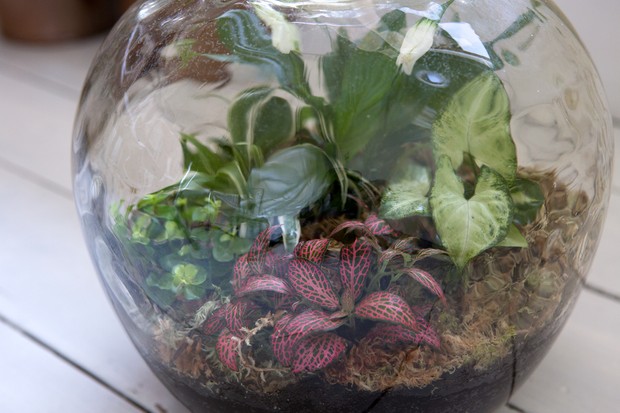
Fittonia is also known as the nerve plant or mosaic plant, because of its striking patterned foliage, a network of veins picked out in a different colour to the oval leaves. There are several vibrant colour schemes to choose from – green and white, green and pink, orange and pink, and the almost day-glo lime and electric pink. Fittonia forms a compact mound of slowly spreading habit, making an attractive specimen plant that holds its own in a room, but also combining well with other foliage plants. It rarely flowers indoors, and many growers pinch out the dainty pale flower spikes that so that the plant concentrates its energy on its leaves. Fittonia has a reputation for being tricky, but if you take a little time to understand its needs, it is a beautiful companion for your home or workspace.
Where to grow fittonia
Fittonia growing in a bottle garden
To grow this plant well you need to know that it comes from the forest floor of tropical South America. That means it does best in bright filtered light and humidity. Try it in the slightly more humid bathroom or kitchen out of direct sunlight (which might scorch its leaves, turning them brown and crispy), or on a north-facing windowsill. Its slow growth and relatively compact size also make it a good choice for a terrarium, planted together with ferns and moss. Avoid placing it near doors or windows where it might experience swings in temperature or draughts.
How to plant fittonia
Plant fittonia in a humus-rich, peat-free house plant compost in a pot with drainage holes at the bottom. Open up the compost by mixing it with vermiculite.
How to care for fittonia
Your fittonia needs careful watering, preferably with filtered water, rainwater or boiled water from the kettle that has cooled. Water it thoroughly and let the pot drain until no more water is dripping through the holes in the bottom of the pot. Allow the compost to almost dry out between watering – sometimes the plant will start to droop, telling you it is time for the next watering (pick up the pot so that you get to know how light it feels when it is drying out).
To maintain humidity, mist the leaves a couple of times a week (this may not be necessary in the bathroom or kitchen, which tend to have more moisture in the air) or sit the pot on a dish or tray containing a layer of pebbles and water, which evaporates to create a microclimate around the plant. Alternatively, create a microhabitat by grouping your fittonia with other leafy house plants.
Your fittonia does not need a lot of food. Feed it every couple of weeks in spring and summer with a liquid plant food, diluted to half the recommended strength. If the plant becomes straggly, prune the stems with sharp scissors or shears. New leaves will form at the cut tips, creating a fuller more compact shape.
If the leaves turn yellow and drop off, you’re probably over watering. If leaves become crispy and brown at the margins, the air is too dry. If the plant starts to drop leaves, light levels might be too low or its position might be too draughty.
How to propagate fittonia

Dividing fittonia. Credit: Will and Madeleine Taylor
As they spread, the stems of fittonias that touch the surface of the compost put out roots. You can detach these rooted plantlets from the mother plant and pot them on. You can also make more plants using stem cuttings. Take a length of stem with three to five leaves, cutting below a leaf node. Remove the bottom leaves and insert the cutting into well drained potting mix. Water it in and then make a mini greenhouse, covering it with a plastic bag or see-through container. Remove the cover after a month and water as normal. It can take up to three months for roots to form.
Pests and diseases
Your fittonia might get scale insects or aphids during the growing season, but these can easily be removed by hand and disposed of.
Advice on buying fittonia
- Fittonia is sold widely in garden and plant centres, interiors stores and some pet shops (as it is non-toxic, fittonia is used in reptile terrariums)
- When it comes to choosing your plant, avoid any that show signs of stress, such as wilting, crisp, discoloured or falling leaves
- Always check under the leaves for insect pests
